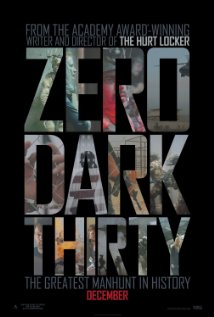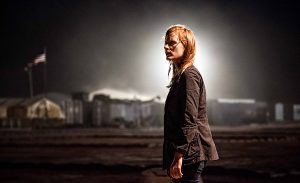Suzanne here,
It would be very easy when creating a movie about the hunt for Osama Bin Laden to take an “America, Fuck Yeah” kind of tone, but director Kathryn Bigelow and writer Mark Boal achieve something much more valuable. Zero Dark Thirty instead presents a quietly intense story about a woman obsessed and a methodical illustration of how U.S. intelligence worked to ultimately take down the architect of 911.
It is apparent from the opening of this movie that this will be understated and straightforward. Instead of flashing the pictures of smoking buildings, mass panic, death and violence that happened on September 11, 2001, there is simply a black screen as chatter on emergency communication lines reminds us of the panic and desperation of that day. The movie then fast-forwards a few years as Maya (Jessica Chastain), a green CIA agent heads to Afghanistan to help in efforts to prevent new terror attacks. When she first arrives, the Bush administration is still in office and efforts to find new intelligence still include torture, and fellow CIA agent Dan (Jason Clarke) quickly introduces Maya to the tactics being used.
Much has been said about the torture scenes in Zero Dark Thirty – that it is pro-torture and too graphic. They are graphic, but it is necessary. Bigelow is illustrating the tactics and just how degrading and dehumanizing they are in order to show the audience what torture means. Whether you are a proponent of torture or not the movie strives to make you aware of what torture means – it should bother you on some level, but I think those strong feelings for or against will walk away feeling the same way they did before.
As Maya, Dan and other CIA agents search for leads they torture and interrogate dozens and dozens of suspected terrorists, review hundreds of hours of video and read through countless pages of information to find small amounts of information that can be tied together. With this information and the breaking of one detainee, Maya latches onto the name of Osama Bin Laden’s courier and doggedly pursues him in spite of threats, personal tragedies and bureaucratic inefficiency. When she and her colleagues finally track down Bin Laden, only she is sure enough to push for the mission.
I appreciated the lack of action-packed sequences in the movie. We only see a few big explosions, but they are not built up and they accurately reflect what happened during real life events. When the Seal team invades Bin Laden’s compound, it is a quiet, routine mission that is more surgical than explosive. This works to make the audience a little more nervous than usual. We know the outcome, but we are still tense. The closest the audience gets to a celebratory, “We killed him!” moment comes when the Seal team is unloading the helicopter, but it actually plays more like a long held breath – many soldiers glad to have one more successful mission with their lives intact.
The acting was great. Chastain easily became a tougher than she looks veteran CIA agent as the movie develops. The rest of the supporting cast did a wonderful job in showing how this work can make people driven at times and exhausted and jaded at other times. Jennifer Ehle, who played a CIA agent in the field with Maya, actually laid on the “southern” accent a bit thick, and it was hard to disassociate James Gandolfini, as Leon Panetta, from his Tony Soprano past, but these were minor issues with an overall well acted film.
As the film closes, Maya boards a cargo plane bound for anywhere, exhausted, emotionally drained – mission accomplished. You can sense that she doesn’t know what to do with herself now. I appreciated that most about Zero Dark Thirty. It is a stark and straightforward telling of one woman’s role in a larger story. It does not treat this event with patriotic fervor; it is not a propaganda film. It lays it out there, the ugly and the good, and even when the mission is accomplished, there are too many things still going on in the world to truly feel satisfied.
– Suzanne Loranc



